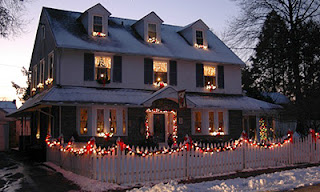If you have shopped for a home recently, you may have
noticed the villa homes that now makeup a good portion of the real estate
landscape. What is a villa you ask? They're not apartments or houses, or even
condominiums. A villa is a new term for an attached or free standing,
maintained home. In most instances, Villa owners own the piece of land their
home sits on. Condo owners only own the airspace inside the condo, not the
land. If owning a piece of planet Earth is on your bucket list, a villa will
let you live that dream.

There are some perceived disadvantages of villa homes, many of which are rooted in a fear of annoying neighbors. Potential buyers worry about disruptions from noisy neighbors, and interference from nosy ones. However, recently built attached homes have well insulated shared walls that effectively soundproof each home. They also are designed to minimize spreading damage in the case of a fire.
Competitive Prices
There are plenty of advantages that make an attached home an
attractive living option that you should really consider. The primary advantage
of attached living lies in its general affordability. In many communities an
attached villa or duplex home can be the same size as a single-family model,
but will usually be offered for a lower price.
Low Maintenance
 Low-maintenance living is another benefit of an attached
home, as the structural exterior, lawn care and snow removal is often the
responsibility of the community. In a villa you will enjoy many community
amenities with less hassle of home and yard maintenance. So you need never
throw out your back bending over to pull one stupid weed again. Often times,
insurance is included in your monthly assessment so your homeowners insurance
may be substantially lower than with a single family home.
Low-maintenance living is another benefit of an attached
home, as the structural exterior, lawn care and snow removal is often the
responsibility of the community. In a villa you will enjoy many community
amenities with less hassle of home and yard maintenance. So you need never
throw out your back bending over to pull one stupid weed again. Often times,
insurance is included in your monthly assessment so your homeowners insurance
may be substantially lower than with a single family home.Of course, every HOA (as the homeowners' association likes to call itself) has a different list of maintenance items it'll take care of, so you'll want to make sure you all agree on who has to do what in the yard.
Community Amenities
When you buy a villa, it comes with a community, and that
community has amenities. Many villa developments have a gym, a pool, a laundry room, tennis
courts and even a recreation room that owners can sign up to use for parties.
Benefits of Close Neighbors
The truth is, a bit of Nosy Nellie-ish behavior does benefit
the neighborhood. Being part of a villa community means neighbors are more
likely to know one another and therefore know if someone new is creeping about.
This makes villa living perfect for frequent travelers who want their home to
remain safe while they are out of town.
For seniors or anyone who is medically fragile, having close neighbors can be a real advantage. In addition retirees can still have the advantage of building equity while not being in a 'retirement home’.
For seniors or anyone who is medically fragile, having close neighbors can be a real advantage. In addition retirees can still have the advantage of building equity while not being in a 'retirement home’.
Unique Living Situations
 The villa housing style opens up options for unique situations. Say for example you need to take care of someone in your family who
needs close supervision, but is also situation where both parties,
yourself and your family member require privacy and space. By living on one
side and having your family member live on the other side, it solves that
dilemma.
The villa housing style opens up options for unique situations. Say for example you need to take care of someone in your family who
needs close supervision, but is also situation where both parties,
yourself and your family member require privacy and space. By living on one
side and having your family member live on the other side, it solves that
dilemma.St. Louis and St. Charles, Missouri area Villa Homes
The St. Louis metropolitan area offers many great villa
homes and communities. The Boehmer Team has helped numerous clients find the
perfect villa home. We also have bountiful experience in new construction and
can assist anyone looking for a brand new villa. Contact The Boehmer Team for
help finding a villa in the price range and area you desire.
Additional References:













